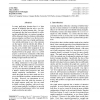Free Online Productivity Tools
i2Speak
i2Symbol
i2OCR
iTex2Img
iWeb2Print
iWeb2Shot
i2Type
iPdf2Split
iPdf2Merge
i2Bopomofo
i2Arabic
i2Style
i2Image
i2PDF
iLatex2Rtf
Sci2ools
108
click to vote
ICML
2004
IEEE
2004
IEEE
Semi-supervised learning using randomized mincuts
In many application domains there is a large amount of unlabeled data but only a very limited amount of labeled training data. One general approach that has been explored for utilizing this unlabeled data is to construct a graph on all the data points based on distance relationships among examples, and then to use the known labels to perform some type of graph partitioning. One natural partitioning to use is the minimum cut that agrees with the labeled data (Blum & Chawla, 2001), which can be thought of as giving the most probable label assignment if one views labels as generated according to a Markov Random Field on the graph. Zhu et al. (2003) propose a cut based on a relaxation of this field, and Joachims (2003) gives an algorithm based on finding an approximate min-ratio cut. In this paper, we extend the mincut approach by adding randomness to the graph structure. The resulting algorithm addresses several shortcomings of the basic mincut approach, and can be given theoretical ...
Related Content
| Added | 17 Nov 2009 |
| Updated | 17 Nov 2009 |
| Type | Conference |
| Year | 2004 |
| Where | ICML |
| Authors | Avrim Blum, John D. Lafferty, Mugizi Robert Rwebangira, Rajashekar Reddy |
Comments (0)

